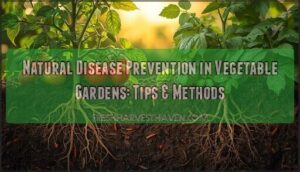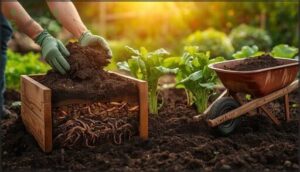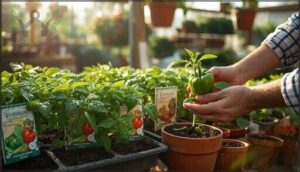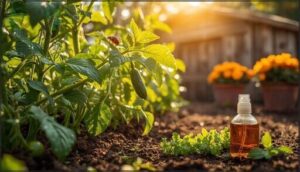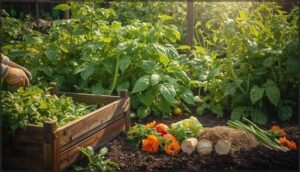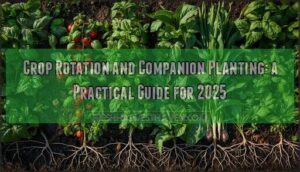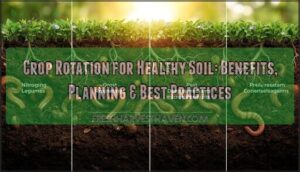This site is supported by our readers. We may earn a commission, at no cost to you, if you purchase through links.
Your tomatoes looked perfect last week, but now dark spots crawl up the stems and leaves curl inward. You didn’t spray anything harmful, watered carefully, and still—disease found a way in. This scenario plays out in countless vegetable gardens each season, not because gardeners lack dedication, but because they’re fighting symptoms instead of building defenses.
Natural disease prevention in vegetable gardens starts long before the first leaf shows trouble. It begins in the soil beneath your feet, in the varieties you choose, and in the rhythm you establish between plantings.
When you strengthen these foundational systems, you create an environment where beneficial organisms outnumber pathogens and plants develop the resilience to fend off infections before they take hold.
Table Of Contents
- Key Takeaways
- Preparing Healthy Soil for Disease Prevention
- Selecting Disease-Resistant Vegetable Varieties
- Implementing Effective Crop Rotation Strategies
- Natural Pest and Disease Prevention Methods
- Sustainable Organic Garden Maintenance Tips
- Frequently Asked Questions (FAQs)
- What is a natural repellent for vegetable gardens?
- How do I keep bugs out of my vegetable garden naturally?
- How do I get rid of diseases in my garden soil?
- How to cure plant diseases naturally?
- What is the best natural pest control for vegetable gardens?
- How to prevent fungus in vegetable garden?
- How to cure plant disease naturally?
- How to prevent disease in a vegetable garden?
- What is the best natural pesticide for vegetable gardens?
- How do I keep bugs from eating my vegetable garden?
- Conclusion
Key Takeaways
- Healthy soil enriched with compost creates a disease-fighting foundation by boosting beneficial microorganisms that naturally suppress pathogens and improve water infiltration by up to 351%.
- Disease-resistant vegetable varieties adapted to your local climate and pest pressures can slash infection rates by 60-90% before you even plant, making variety selection one of your smartest defense strategies.
- Crop rotation every three to four years disrupts pathogen lifecycles and reduces soil-borne diseases by up to 90% while naturally balancing soil fertility through strategic planting sequences.
- Natural prevention methods like proper plant spacing, early morning watering at soil level, and weekly removal of infected foliage can cut fungal diseases by 30-80% without chemical intervention.
Preparing Healthy Soil for Disease Prevention
Healthy soil is your garden’s first line of defense against disease. When you build a strong foundation underground, your plants can naturally resist infections before they even start.
Let’s look at three essential soil practices that set you up for success.
Improving Soil With Compost and Organic Matter
Beyond any fancy product, compost application transforms your garden into a disease-fighting powerhouse. When you add organic matter, you’re feeding billions of beneficial microorganisms that outcompete pathogens. Studies show composting increases bacterial abundance by 10% in just eight weeks while boosting soil structure and nutrient cycling. One major advantage is that it helps with sustainable management of food and other waste.
Here’s what healthy soil fertility delivers:
- Improved water infiltration by 351% compared to non-amended beds
- Pathogen suppression against common vegetable diseases like Fusarium
- Enhanced soil structure with up to 52% better porosity
- Natural sustainability benefits through carbon sequestration
- Long-term nutrient availability without synthetic fertilizers
Maintaining Proper Soil PH and Nutrients
While compost builds structure, soil testing frequency matters just as much for disease prevention. Most vegetable plants thrive in the best pH range of 6.0 to 7.0, where nutrient uptake efficiency peaks and microbial activity flourishes.
Test your soil annually to catch imbalances early. Use pH adjusting methods like lime to raise acidity or sulfur to lower it, maintaining healthy soil that naturally fights pathogens.
For example, carrots prefer acidity with a pH between 5.5 and 6.5.
Mulching for Moisture Control and Protection
After balancing pH, mulch becomes your frontline defense. A 2-3 inch layer of straw or shredded hardwood conserves soil moisture while acting as a disease barrier that prevents pathogens from splashing onto leaves.
Different mulch types offer unique benefits—composted bark improves soil health as it breaks down, while straw excels at water conservation. This simple practice cuts irrigation needs and blocks disease transmission from contaminated soil.
Selecting Disease-Resistant Vegetable Varieties
Choosing the right vegetable varieties is one of the smartest shortcuts to a healthier garden. Disease-resistant plants can cut infection rates by 60 to 90 percent compared to standard varieties, giving you a real advantage before you even break ground.
Disease-resistant vegetable varieties cut infection rates by 60 to 90 percent before you even plant
Here’s how to select varieties that’ll thrive in your specific conditions and naturally fend off local threats.
Researching Local Pest and Disease Issues
Your vegetable garden faces unique pest and disease challenges based on where you live. Before you plant a single seed, take time to understand what problems show up most often in your area. This research gives you control over disease prevention and helps you make informed decisions.
Here’s how to identify local pest issues:
- Connect with your county Extension office – They maintain records of regional pest outbreaks and disease trends specific to your growing zone.
- Review monitoring practices – Extension services often publish pest calendars showing when cucumber beetles, aphids, or blight generally appear in your region.
- Study risk assessments – Official reports reveal which garden pests target specific crops, like imported cabbageworm on cole crops or bacterial wilt in cucurbits.
- Learn adaptation strategies – Local data shows resistant varieties can cut disease incidence by 30% to 60% in heavily affected areas.
Regional pest ID starts with recognizing patterns. Aphids affect up to 15 vegetable types across U.S. gardens, while flea beetles target seven major vegetable families. In northern regions, cutworms and seedcorn maggots dominate early-season damage. Southeastern gardeners often battle harlequin bugs on beans and tomatoes.
Disease outbreak trends tell an equally important story. Anthracnose and bacterial wilt plague cucurbits, requiring two-year rotations. Tobacco mosaic virus spreads through contaminated tools in pepper and tomato patches. Downy mildew thrives in poorly drained onion beds, while purple blotch strikes during humid periods.
Weekly monitoring practices during active growing seasons help you spot problems early. Automatic identification systems now achieve 96% accuracy, but your regular garden walks remain your best defense. Yellow sticky traps catch small, mobile pests before populations explode.
This groundwork transforms how you approach plant diseases and garden health. When you understand regional climates and their associated risks, you can select varieties bred to withstand your specific challenges.
Choosing Varieties for Regional Climates
Matching plant varieties to your local climate is one of the smartest moves you can make. Climate-adapted cultivars thrive in your regional pest pressures and soil types, delivering up to 25% higher yields than generic selections.
When selecting disease-resistant plants for seasonal growing windows, consider microclimate considerations like frost dates and heat patterns. Resistant varieties selection adapted to local conditions reduces disease losses considerably.
Consulting Local Gardeners and Extension Services
Beyond reading seed catalogs, tapping into local expertise transforms your disease prevention strategy. Extension service access and peer knowledge sharing deliver climate-specific insights you won’t find online.
- Extension diagnostics identified problems for 26% of gardeners who saved ailing crops that season
- Community garden networks host educational events in 73% of participating gardens
- Master Gardeners answered 2,559 disease questions and processed 308 samples annually
- Growers prefer locally adapted advice from extension professionals for rapid problem-solving
- Women represent 65% of rural gardening program participants, strengthening peer knowledge transfer
Local climate insights and diagnostic service value make extension services your secret weapon for plant health.
Understanding Plant Immunity and Resistance Ratings
Immunity isn’t binary—plants defend themselves through genetic resistance and induced immunity triggered by environmental factors. When selecting disease-resistant plants, resistance ratings (scaled 1-9) translate directly to performance: a rating of 9 means under 5% infection even when disease pressure peaks. Understanding plant immunity helps decode seed catalogs and match varieties to regional threats.
| Resistance Type | How It Works |
|---|---|
| Genetic Resistance | Single dominant R genes trigger immune responses; over 80% of modern vegetable pest and disease resistance relies on these |
| Induced Immunity | Salicylic acid applications boost antioxidant activity by 40%, while diet’s role in plant health strengthens systemic defenses |
| Environmental Factors | Drought stress can upregulate immunity genes by 26%, improving innate resistance in stressed crops |
Implementing Effective Crop Rotation Strategies
Crop rotation isn’t just an old farming trick—it’s one of your best defenses against soil-borne diseases and nutrient depletion. When you move crops to different spots each season, you disrupt the life cycles of pathogens and pests that thrive on specific plant families.
Here’s how to put rotation to work in your vegetable garden.
Rotating Crops Every Three to Four Years
Think of crop rotation as resetting your garden’s clock every three to four years. This simple practice slashes soil-borne diseases by up to 90% by disrupting pathogen lifecycles that depend on specific host plants.
You’ll also boost yields by 10-25% as rotation naturally balances soil fertility—legumes replenish nitrogen while heavy feeders draw it down, creating a self-sustaining cycle.
Avoiding Planting The Same Crop Family Repeatedly
Planting the same crop family year after year invites disaster—pathogen accumulation climbs by 80%, and disease-prone families like brassicas and nightshades suffer 40-60% higher infection rates. You’ll see yields drop 7-13% as soilborne pathogens multiply.
The fix? Rotate unrelated plant families through your beds. Long-term benefits include healthier soil microbes and fewer disease outbreaks, protecting your garden’s future productivity.
Managing Soil Fertility Through Rotation
Crop rotation strategies transform soil fertility management into a self-sustaining system. Legume integration adds 45–81 kg/ha of nitrogen for your next plantings, cutting synthetic fertilizer needs by 41%.
Nutrient cycling through diverse sequences retains 32% more minerals than monoculture while boosting organic matter by 16–32%. Rotation benefits extend to healthier soil microbes and improved structure.
Strategic soil amendments between cycles complete this fertility-building approach.
Combining Rotation With Companion Planting
Pairing crop rotation strategies with companion planting benefits delivers a powerful disease cycle break. This combination boosts microbial diversity while suppressing pathogens by up to 90% over three-year cycles.
You’ll see pest population control improve naturally as diverse planting patterns support beneficial predators.
The result? Soil fertility gains and sustainable garden yields that outperform single-method approaches by 10–25%, proving natural disease prevention really works.
Natural Pest and Disease Prevention Methods
You’ve laid the groundwork with healthy soil and smart crop choices, but keeping pests and diseases at bay requires consistent, proactive methods.
The good news is that nature provides powerful tools—from homemade sprays to beneficial insects—that work without harsh chemicals.
Let’s walk through four core practices that form your natural defense system.
Applying Natural Repellents and Homemade Sprays
Beyond crop rotation and resistant varieties, you can create powerful barriers against garden threats with simple kitchen ingredients.
Here are three tried-and-true homemade sprays for pest control:
- Garlic spray – Though it shows under 20% mortality on some pests, combining garlic with other ingredients boosts effectiveness considerably
- Neem oil – Disrupts feeding behavior and inhibits fungal spore germination by up to 48%
- Pepper spray – Demonstrates 67% effectiveness against cricket damage; reapply after rainfall
Utilizing Beneficial Insects and Microorganisms
While sprays knock down existing pests, you can enlist living allies to patrol your garden 24/7. Beneficial insects like lady beetles and lacewings reduce aphid populations by up to 80% in real-world trials. Meanwhile, beneficial microorganisms including Bacillus and Trichoderma species trigger plant defenses comparable to chemical controls, slashing disease severity by 60% in cabbage and tomato studies.
Here’s how insect predators and microbial inoculants deliver ecosystem services:
| Natural Ally | Disease Suppression Benefit |
|---|---|
| Lady beetles & lacewings | Cut aphid numbers 80%; prevent virus spread |
| Ground beetles | Reduce slug densities 40%; lower fungal risk |
| Bacillus species | Trigger systemic resistance in tomatoes |
| Trichoderma fungi | Block soil pathogens; 60% disease reduction |
| Streptomyces bacteria | Inhibit bacterial growth via natural compounds |
Adoption trends show gardeners increasingly turn to these microscopic helpers—commercial releases grew 12% annually from 2020 to 2025. You’re joining thousands who’ve slashed pesticide use by 20–80% while improving natural disease prevention.
In greenhouse settings, beneficial insect releases achieve 75% pest reductions, proving that working with nature strengthens vegetable garden defenses far better than fighting against it.
Practicing Proper Spacing and Air Circulation
Once you’ve recruited beneficial allies, give them—and your plants—room to work. Proper spacing isn’t just about convenience; it’s disease prevention at its simplest.
Tomatoes spaced at 24 inches show 30% fewer fungal infections than those crammed at 12 inches. That’s because ideal spacing and air circulation slash leaf wetness by 40%, denying pathogens the damp conditions they need to thrive.
Watering Techniques to Reduce Disease Risk
In water management, timing and technique matter as much as volume. Drip irrigation or soaker hoses deliver moisture straight to the soil, cutting fungal diseases by up to 40% compared to overhead watering. Water early—before 8 a.m.—so foliage dries quickly.
Deep, infrequent sessions promote healthier roots while reducing surface humidity that invites infection.
Sustainable Organic Garden Maintenance Tips
Once you’ve laid the groundwork with healthy soil and smart prevention, maintaining that success comes down to a few key practices. The way you care for your garden throughout the season—what you avoid, how you clean up, and what you add back—determines whether diseases gain a foothold or stay at bay.
Here are the essential habits that keep your organic vegetable garden thriving naturally.
Avoiding Chemical Pesticides to Protect Soil Health
Skipping chemical pesticides protects the invisible world beneath your feet—where roughly 10 to 100 million organisms per handful work to cycle nutrients and suppress disease naturally. These substances harm soil invertebrates in 71% of cases studied, killing earthworms and beneficial insects essential for healthy soil.
Choosing natural pest control and organic gardening methods preserves microbial diversity, boosts organic matter, and prevents chemical degradation that undermines long-term disease prevention.
Practicing Good Garden Sanitation and Hygiene
When disease strikes, your response matters more than you might think. Weekly removal of infected foliage can cut disease spread by up to 80%, turning the tide on pathogens before they multiply.
Follow these essential hygiene protocols for natural disease prevention:
- Tool Disinfection: Clean pruners and shovels with 70% alcohol after each use to stop pathogen transfer.
- Prompt Plant Removal: Bag and dispose of diseased material—never compost it.
- Avoid Contamination: Work dry and separate healthy from sick plants to protect your healthy soil.
Monitoring and Early Detection of Problems
Think of your garden as a patient—regular visual inspections catch problems before they spiral. Weekly checks can spot symptoms early, slashing disease spread by up to 45%.
For larger plots, remote sensing and data tracking pinpoint trouble zones you’d otherwise miss.
Community networks share local pest alerts, amplifying your preventative measures. Early intervention impact? Studies show 20–30% fewer crop losses when you act fast on plant health signals.
Using Cover Crops and Organic Amendments
Cover crops like rye and rapeseed slash soil pathogen populations while boosting microbial diversity enhancement by nearly 80%. Organic amendments improve soil properties—raising pH by 25% and carbon content by 17%—while promoting resource competition that starves pathogens.
This combo delivers yield growth benefits through disease prevention: healthier roots, stronger plants, and sustainable harvests season after season.
Frequently Asked Questions (FAQs)
What is a natural repellent for vegetable gardens?
Your best options include garlic-chili sprays, neem oil, and companion plants like marigolds or basil.
Field trials show these botanical repellents reduce pest damage by 45-70% when applied consistently every week or two.
How do I keep bugs out of my vegetable garden naturally?
Picture ladybugs patrolling your tomato plants like tiny security guards. You’ll keep bugs away naturally using beneficial insects, companion planting with marigolds and basil, homemade sprays, and organic barriers like row covers.
How do I get rid of diseases in my garden soil?
Soil solarization uses clear plastic to heat soil and kill pathogens during summer.
Steam sterilization, biofumigation with cover crops, and disease-suppressive soils enriched with compost amendments effectively eliminate soilborne diseases while rebuilding healthy soil.
How to cure plant diseases naturally?
Ironically, truly “curing” infected plants naturally proves nearly impossible—prevention wins.
Focus on biofungicide application, homemade sprays, systemic resistance through organic amendments, cultural practices strengthening plant immunity, and natural remedies before disease establishes itself.
What is the best natural pest control for vegetable gardens?
Natural pest control methods work best as a layered system. Neem oil addresses up to 90% of garden pests, while insecticidal soap and garlic spray handle soft-bodied insects. Companion plants and diatomaceous earth complete your defense strategy.
How to prevent fungus in vegetable garden?
A Florida gardener lost an entire tomato crop to late blight in 72 hours.
You can prevent fungal diseases by improving airflow through proper spacing, watering at soil level early mornings, and rotating crops every three years to break pathogen cycles.
How to cure plant disease naturally?
You can treat infected plants with garlic-based sprays, chamomile tea, baking soda solutions, or diluted milk to suppress fungal diseases.
These homemade remedies support plant immunity while targeting pathogens naturally without harsh chemicals.
How to prevent disease in a vegetable garden?
Think of your vegetable garden as a fortress—strong defenses start beneath the surface. Disease prevention hinges on soil health, crop rotation, pest control, garden hygiene, and choosing resistant varieties for organic gardening success.
What is the best natural pesticide for vegetable gardens?
Your best options are neem oil, Bt sprays, and insecticidal soap. Diatomaceous earth works well for soil pests, while garlic spray offers budget-friendly protection.
IPM effectiveness improves when you rotate these natural pesticides regularly.
How do I keep bugs from eating my vegetable garden?
You can stop bugs by combining physical barriers like row covers, companion planting with pest-repelling species, natural predators such as lady beetles, and understanding bug lifecycles to disrupt their development through strategic trap cropping.
Conclusion
Prevention pays permanent dividends when you protect your plants from the ground up. The methods covered here—healthy soil, resistant varieties, smart rotation, and vigilant maintenance—form the backbone of natural disease prevention in vegetable gardens.
You won’t eliminate every threat, but you’ll shift the balance in your favor. Strong roots, clean practices, and seasonal awareness become your frontline defense, letting you grow food that thrives without synthetic intervention.
- https://www.thrivelot.com/resources/5-crop-rotation-tips-to-prevent-plant-diseases
- https://pmc.ncbi.nlm.nih.gov/articles/PMC8541133/
- https://extension.umn.edu/planting-and-growing-guides/managing-plant-diseases-home-garden
- https://home.howstuffworks.com/green-living/homemade-organic-gardening-sprays.htm
- https://extension.missouri.edu/publications/g6220

